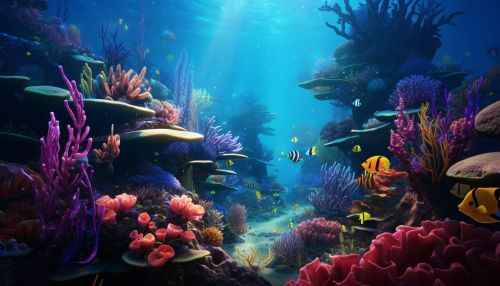Aquatic ecosystems
Introduction
Aquatic ecosystems are complex environments that encompass both marine and freshwater systems. They are characterized by the presence of water, which is the primary medium that facilitates the interaction of biotic (living) and abiotic (non-living) components. These ecosystems are home to a diverse array of organisms, ranging from microscopic plankton to large marine mammals, all of which contribute to the overall structure and function of the ecosystem.
Types of Aquatic Ecosystems
Aquatic ecosystems can be broadly classified into two types: marine ecosystems and freshwater ecosystems.
Marine Ecosystems


Marine ecosystems, which include oceans, seas, and coral reefs, cover approximately 71% of the Earth's surface. They are characterized by high salt content, typically around 35 parts per thousand. Marine ecosystems are further divided into different zones based on factors such as depth, distance from shore, and light penetration. These include the intertidal zone, neritic zone, oceanic zone, and benthic zone.
Freshwater Ecosystems
Freshwater ecosystems, on the other hand, have a low salt content, usually less than 1%. They cover only a small fraction of the Earth's surface but host a significant proportion of the world's biodiversity. Freshwater ecosystems include rivers, lakes, ponds, wetlands, and streams. They are also classified into lotic (flowing water) systems, such as rivers and streams, and lentic (still water) systems, such as lakes and ponds.
Biotic Components of Aquatic Ecosystems
The biotic components of aquatic ecosystems include various organisms that interact with each other and with their environment. These organisms can be classified into three main groups: producers, consumers, and decomposers.
Producers
Producers, or autotrophs, are organisms that can produce their own food through photosynthesis or chemosynthesis. In aquatic ecosystems, the primary producers are often phytoplankton, algae, and some types of bacteria. These organisms form the base of the food web, providing energy for other organisms.
Consumers
Consumers, or heterotrophs, are organisms that cannot produce their own food and must consume other organisms for energy. In aquatic ecosystems, consumers include a wide range of organisms, from tiny zooplankton to large predators such as fish, birds, and mammals. Consumers can be further classified into primary, secondary, and tertiary consumers based on their position in the food chain.
Decomposers
Decomposers are organisms that break down dead or decaying organisms, recycling nutrients back into the ecosystem. In aquatic ecosystems, decomposers include bacteria, fungi, and certain types of invertebrates.
Abiotic Components of Aquatic Ecosystems
The abiotic components of aquatic ecosystems include physical and chemical factors that influence the organisms within the ecosystem. These include water, light, temperature, salinity, pH, and nutrients.
Water
Water is the most fundamental abiotic component of aquatic ecosystems. It serves as the medium for chemical reactions and provides the environment in which aquatic organisms live.
Light
Light is essential for photosynthesis, which is carried out by producers in the ecosystem. The amount of light available in an aquatic ecosystem can vary depending on factors such as depth and water clarity.
Temperature
Temperature affects the metabolic rates of organisms and can influence the distribution of organisms within an aquatic ecosystem. For example, certain species may only be able to survive within a specific temperature range.
Salinity
Salinity, or the concentration of salt in water, can greatly influence the types of organisms that can survive in an aquatic ecosystem. Marine ecosystems typically have high salinity, while freshwater ecosystems have low salinity.
pH
The pH of water, or its acidity or alkalinity, can also affect the survival and distribution of organisms. Most aquatic organisms prefer a pH range of 6.5 to 8.5.
Nutrients
Nutrients, such as nitrogen and phosphorus, are essential for the growth and survival of organisms. However, excessive nutrients can lead to problems such as eutrophication.
Threats to Aquatic Ecosystems
Aquatic ecosystems face numerous threats, many of which are caused by human activities. These threats include pollution, overfishing, climate change, habitat destruction, and invasive species.
Pollution
Pollution, including chemical pollution, plastic pollution, and oil spills, can have devastating effects on aquatic ecosystems. These pollutants can harm or kill organisms, disrupt food chains, and degrade habitats.
Overfishing
Overfishing can lead to the depletion of fish stocks, disrupting the balance of the ecosystem and potentially leading to the collapse of the entire ecosystem.
Climate Change
Climate change can lead to changes in temperature and precipitation patterns, sea level rise, and ocean acidification, all of which can negatively impact aquatic ecosystems.
Habitat Destruction
Habitat destruction, such as the destruction of mangroves, coral reefs, and wetlands, can lead to the loss of biodiversity and the degradation of ecosystem services.
Invasive Species
Invasive species can outcompete native species for resources, disrupt food chains, and alter habitats, leading to declines in biodiversity.
Conservation of Aquatic Ecosystems
Conservation efforts for aquatic ecosystems aim to protect and restore these vital habitats. These efforts include the establishment of protected areas, pollution control, sustainable fishing practices, and habitat restoration.
